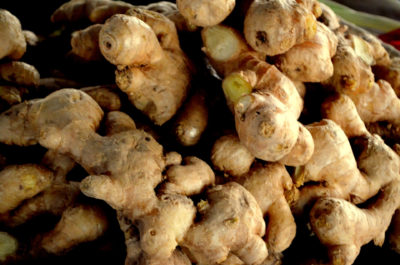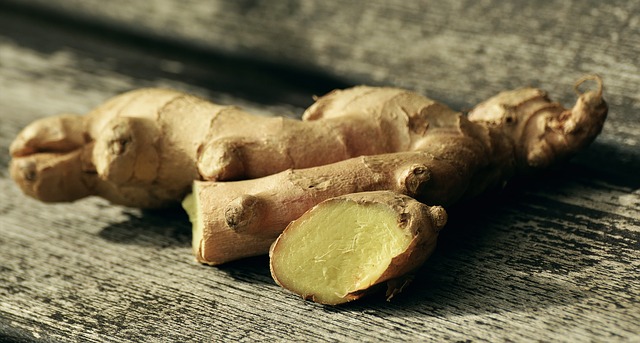Ginger is one of those ingredients that warms you from the inside out. It is especially great to have during winter as part of soups, teas, juices, Asian dishes and herbal remedies.
And if you like to grow your own food, you’ll be happy to know that ginger is very easy to grow indoors – and for most of us in North America, growing this herb indoors is actually preferable than growing it outdoors.
Ginger is an extremely low-maintenance plant that does well in partial sunlight. Because it takes about 10 months to mature and does not tolerate frost or strong winds, growing it as a houseplant is the best solution for most vegetable gardeners.
The roots can be easily dug up and bits removed for cooking, and the remaining root re-covered. In other words, once you’ve started growing this bright and spicy root, it’s possible to have a never-ending supply.
Need Non-GMO Salad Green Seeds? Get Them From A Company You Can Trust!
And because it is so low maintenance, it is a great plant for anyone who is new to indoor gardening, provided they have the necessary patience to wait for that first harvest.
Selecting Your Ginger
For best results, it is recommended that you purchase seed ginger from a garden center or from a fellow gardener who already has a healthy plant.
Look for a rhizome that is plump with fairly smooth skin. You should notice several “eye buds” on it – similar to potato eyes. If you’d like to start more than one plant, you may cut the root into sections as long as each section has a few eye buds.
Ginger root purchased from a grocery store might not work, since it’s possible it was sprayed with a growth inhibitor which is meant to prevent it from sprouting after harvested. Store-bought ginger also may have pesticides and other chemicals on it.
If you do decide to try growing a plant from store-bought ginger, it is recommended that you soak the root in water overnight. This will help to remove some of the growth inhibitor and pesticides and give you a better chance of success.
Ginger root grows horizontally rather than down, so the best pot for growing ginger indoors is one that is fairly wide and shallow. Fill your pot with well-draining potting soil.
Planting and Caring
Begin by soaking your ginger rhizome in lukewarm water overnight. Then plant your ginger one to two inches deep with the eye bud at the top. Cover the root and water well.
 Place the pot in an area of your home that is warm but that doesn’t get a lot of direct sunlight. Ensure that you keep the soil moist, either through light watering or with a spray bottle. After a few weeks, you’ll notice tiny shoots emerging from the soil.
Place the pot in an area of your home that is warm but that doesn’t get a lot of direct sunlight. Ensure that you keep the soil moist, either through light watering or with a spray bottle. After a few weeks, you’ll notice tiny shoots emerging from the soil.
Continue to mist regularly and keep the area warm. Some gardeners like to put their containers outside during the warmer weather and bring them in for colder months. As long as your plant is kept sheltered from strong winds, too much rain and direct sunlight, this is fine.
It also is OK to keep the plant indoors year-round.
Will My Ginger Flower?
Many people understandably get confused between the beautiful red and orange flowering gingers that they see in garden centers and culinary ginger, which is the topic of this article. While culinary ginger does flower after the plant is about two years old, its flowers are small and green – and not the flashy showpieces that the ornamental varieties produce.
Harvesting Ginger
The ginger plant is a slow grower, so in the early stages it is necessary to have some patience. Once the shoots emerge from the soil, you should wait another three to four months before you begin harvesting. But don’t worry – the wait will have been worth it!
To harvest your ginger, pull back some of the soil from the edge of the pot until you find part of the root underneath. Cut off the amount that you want and then cover the remaining root back up with soil. At first, you should only take small amounts, but since a little ginger can go a long way this will be ok for most recipes or herbal remedies.
Should you wish to use a larger amount of ginger, you may dig up the whole plant. Just keep in mind that in doing so, you’ll have to start the whole process over again if you wish to continue growing ginger.
If. however, you are patient and don’t take too much in those first few harvests, you will soon find yourself with an abundance of rhizomes that you can use in your kitchen, divide into other pots and share with friends and family.
What advice would you add? Share your tips in the section below:
Every Year, Gardeners Make This Stupid Mistake — But You Don’t Have To. Read More Here.
 Off The Grid News Better Ideas For Off The Grid Living
Off The Grid News Better Ideas For Off The Grid Living




